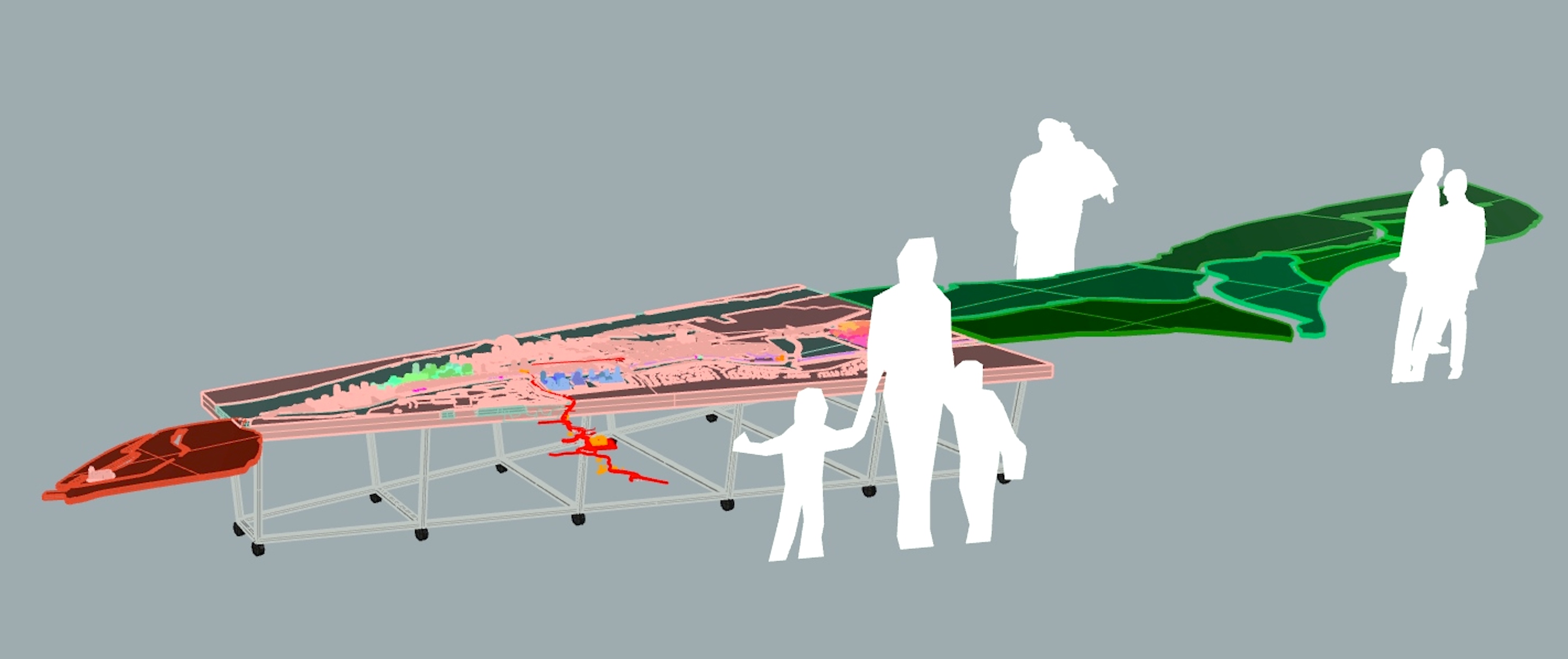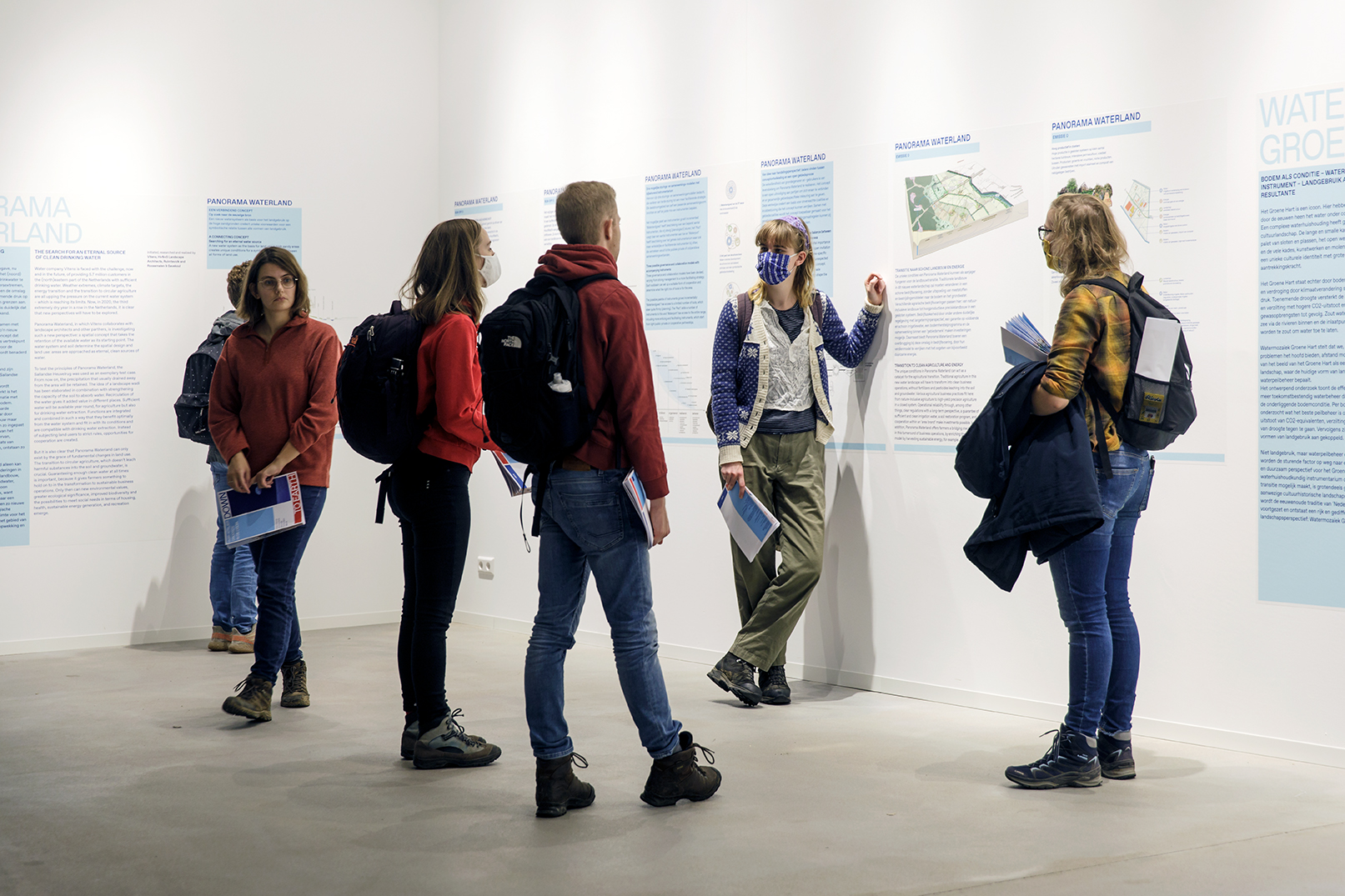IABR–2018+2020–THE MISSING LINK
4 May 2021 |
| DOWN TO EARTH opens agains |
|
|
While we looked ahead to the 2022 edition of the IABR, SHOCK AND ROLL, in the previous newsletter, this time the focus is once again on the current edition, which we’ve been ‘unfolding’ since September 2020.
It’s hardly surprising that it’s been quite a struggle to unfold. The exhibition WHOSE ENERGY IS IT, ANYWAY? had to close its doors in December after only being open for three weeks. The partner exhibition METEOPOLIS was built in the Keilezaal in early January, but was never allowed to open and could only be visited virtually – in fact, it still can.
The current exhibition, NOW! DESIGNING IN TIMES OF CLIMATE CRISIS, was actually created especially for Instagram. Through 26 May, NOW!, curated by 150 students from the Rotterdam Academy of Architecture and the Graphic Design (BA) and Non-Linear Narrative (MA) departments of the Royal Academy of Art in The Hague, can still be seen on Instagram – username: @downtoearth_now.
However, looking at the upcoming, final months of DOWN TO EARTH, it now looks like the lockdown measures may be relaxed enough by the end of May to allow our doors to reopen. Nothing is certain, but it’s now reasonable to assume that we can. It’s why we’re working on three exhibitions that will be open to the public, starting almost simultaneously in about a month’s time: RECLAIMING THE COMMONS in the Keilezaal in Rotterdam; the WATERSCHOOL M4H+ in the Merwe-Vierhavens area in Rotterdam, in Studio Makkink & Bey’s studio and in public space; and THE HIGH GROUND in the Biesboschhal in Dordrecht. |
|
| RECLAIMING THE COMMONS | .jpg?v=20210503171901) | | photograph: Aad Hoogendoorn | RECLAIMING THE COMMONS builds on WHOSE ENERGY IS IT, ANYWAY?, the exhibition that could not be visited by many people because of the Covid restrictions that were in place in the autumn and that was forced to close its doors after only three weeks due to the complete lockdown. Important components of WHOSE ENERGY IS IT, ANYWAY? have been retained, most of them further developed, in RECLAIMING THE COMMONS. There are also new elements, of course, since the IABR–Atelier Rotterdam has not been idle, and its research by design is the premise of both exhibitions.
WHOSE ENERGY IS IT, ANYWAY? focused on the energy transition at the district level, on the energy district as an energetic district. In RECLAIMING THE COMMONS the curators, George Brugmans and Thijs van Spaandonk, go a step further. Their starting point is the observation that energy was once part of the commons: that which belongs to all of us and that we take care of together. And that we might want to look at it that way again: after all, since the sun, wind and hydrogen belong to everyone, the transition to sustainable energy should belong to us all, too. So how can we reinvent the commons for the twenty-first century? The energy transition is the elephant in the room of politics. It’s high time to say: No energy transition without social transition – RECLAIM THE COMMONS!
RECLAIMING THE COMMONS is on view in the Keilezaal in Rotterdam, and (subject to change) open from Friday, 28 May to Sunday, 11 July 2021.
Please note that, given the pandemic, IABR follows the guidelines of the Dutch Health Authority. This way, we can ensure that there are never too many people present at the same time and that every visit is a safe visit. Therefore, visitors have to reserve times slots, which you can do by clicking here.
|
|
|
| THE HIGH GROUND |  | | Artist’s Impression The High Ground, model of De Staart (Made by Mistake) | The exhibition THE HIGH GROUND presents the results of IABR–Atelier Dordrecht. This year marks the 600th anniversary of the St. Elizabeth’s Flood, the greatest water disaster in the history of the Netherlands that wreaked havoc on the city of Dordrecht. The then thriving town was turned into an island, which to this day remains highly vulnerable to flooding. Water safety is therefore of the highest possible priority. Since late 2019, Atelier Dordrecht – with Dordrecht native Adriaan Geuze (West 8) as its lead designer – the IABR, and the municipality of Dordrecht have been investigating how water safety can be used as a lever for the sustainable development of De Staart, the somewhat elevated district on the north side of the city. In accordance with the objectives of the IABR, the Sustainable Development Goals of the United Nations played an important guiding role in this research.
The research by design done by West 8, supplemented by studies carried out by four other design agencies – PosadMaxwan, Studio Donna van Milligen Bielke, EGM, and VenhoevenCS – has now been concluded. The results make clear that De Staart, now an area with many problems and little perspective, can play an unexpectedly important role in realizing the Dordrecht water safety agenda if sustainable and inclusive urban development of new living-working environments is initiated there. No wonder both the Safety Region and the Municipal Executive of Dordrecht immediately responded enthusiastically to the results.
THE HIGH GROUND, an IABR exhibition in the Biesboschhal in De Staart that is part of the major St. Elizabeth’s Flood commemoration in Dordrecht, will present the results. From the beginning of June it will serve as an ‘arena’ for work sessions and discussions with administrators, experts, and all possible stakeholders, from the residents of De Staart to the central government’s Directorate-General for Public Works and Water Management, but from 3 July to mid-August it will be open to everyone.
|
|
|
| PUBLIC SURVEY |  | | photograph: Aad Hoogendoorn | When THE HIGH GROUND closes at the end of the summer, DOWN TO EARTH will have lasted a year. Surveys we conducted of visitors to the two exhibitions in the fall of 2020 show that three-quarters of the respondents had no problem at all with the ‘unfolding’ of the biennale program over a longer period of time. ‘Less hectic and more focus on the content’ and ‘a good chance to visit more often’ are answers that are often given. Of course, for people who have to come from further afield, this is a bit more nuanced. And there are a few who prefer to be confronted with ‘a lot at once’ because it makes it easier to connect the dots. But all in all, we can conclude that folding out the biennale was not only a much better solution than canceling it, but that, as has often been the case with the corona crisis, it also provides food for thought about how to continue, in this case, when it comes to the approach to future biennales.
More than half of the visitors attended previous biennales, and 90 percent are positive about the Keilezaal as a permanent location. Although slightly more than half were professionally involved in water management or the energy transition, most were still inspired by the exhibitions or even say it gave them new ideas. Our visitors are of all ages and remarkably often women – or at least they were the ones, who responded to our questionnaire: 65 percent.
We were very keen to hear the answer to the question of how important people considered it to be that the IABR, as a cultural organization, has put the Sustainable Development Goals of the United Nations so central in its policy and integrates them as a concrete starting point in all its research and projects. 85 percent of the respondents said they fully support this, and 90 percent consider the SDGs to be important to very important. That is very encouraging.
Finally, this newsletter proves to be an important communication channel. Asked how people stay informed about our activities, almost half mention the newsletter and over a quarter the website. Social media follow at a great distance. In the coming months you can therefore expect newsletters from us more often than usual. To start with in about two weeks, when we’ll focus on WATERSCHOOL M4H+ by Studio Makkink & Bey. |
|
|
|
You
are receiving this newsletter because you have either signed up for it or
expressed an interest in the activities of the IABR in some other way. If you
don't want to receive this newsletter (any longer), you can unsubscribe below.
We will then destroy the personal data that we hold about you: no hard
feelings!
|

|
|

.jpg?v=20210503171901)


